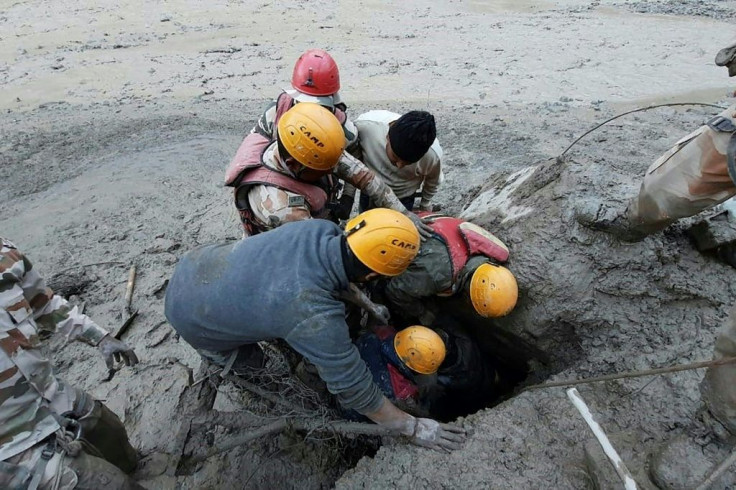Chinese Sabotage Or Glacial Lake Burst? Mystery Deepens Around Massive Himalayan Floods In India
KEY POINTS
- Some Indian defense scientists hint at sabotage angle: report
- Two Indian power projects suffered massive damage in the floods
- Glaciologists say there were no big glacial lakes in the region
- Climate change has been cited as a contributing factor
Indian scientists are baffled by the cause of the massive flash floods in India's Himalayan region that has left massive devastation in its wake and left hundreds missing. With Indian troops in an eyeball-to-eyeball standoff with Chinese troops in the border areas, suspicion of a sabotage angle is adding to the mystery surrounding the cause of the rare disaster.
Rescue operations are still on for people missing after floodwaters in the northern Uttarakhand state Sunday washed away dams and other infrastructure in the border region. The floods were triggered when a glacier broke off in Joshimath, causing the Dhauli Ganga river to flood.
Such flash floods are not uncommon in the Himalayan region and are usually caused by cloud bursts, avalanches or even the bursting of glacial lakes. A flash flood in 2013, caused by cloudbursts, resulted in floods across the state that washed away entire villages and settlements and trapped 12,000 pilgrims in Badrinath, one of Hinduism's most holy sites.
But H.C. Nainwal, a glaciologist at the Hemwati Nandan Bahuguna Garhwal University in Srinagar, Uttarakhand, said there were no big glacial lakes in the region. "An avalanche is quite common, and there could have been one, but an avalanche on its own would not result in an increase in the flow of water in the river. The water has to come from a source, and as of now, we do not know what this source is,” he told The Indian Express.
Experts also ruled out cloudbursts as it is unlikely to happen at this time of the year. The weather reports in the Chamoli district showed sunny weather till Monday with no record of precipitation.
Deepening the mystery, glacier lakes — even if there was one — don't usually burst at this time of the year, especially in an area surrounded by snow-capped mountains and where the temperatures hover around minus 20 degree Celsius. A team of scientists from India's Defense Geoinformatics Research Establishment is now headed to the disaster site to find out what caused the glacier to break off.
Some Indian defense scientists think the glacier burst could have been sabotage -- "an attempt to hit the key Rishiganga hydropower project near Raini village." The power project was almost completely washed away by the floodwaters, and the National Thermo Power Corporation’s under-construction project on the river Dhauli Ganga near Tapovan was damaged.
Indian news magazine The Week reported about this suspicion in defense circles, without naming its sources. The suspicions are deepened by the border standoff between Indian and Chinese troops, not far from where the floods occurred. These sources point out — without really naming China — that glacial lakes can be breached through remote-controlled explosions, with an aim to hit India's infrastructure in the border areas. Both countries have been racing to build up border infrastructure to deploy troops quicker.
India accused Chinese troops of trying to change the status-quo on the disputed border through intrusions, which led to a skirmish that led to scores of troops dead on both sides last May. The standoff has continued through the Himalayan winter, despite the biting cold's impact on men and machinery.
The disaster has triggered calls by environment groups for a review of power projects in the mountains. Climate change has also been cited as a contributing factor to the flood's impact.
Meanwhile, 19 bodies were recovered from the Tapovan power plant site. According to Uttarakhand police chief Ashok Kumar, 32 people from the first tunnel of the Tapovan project and 121 people from the second tunnel are missing. The Indo-Tibetan Border Police and the National Disaster Response Force have launched a massive rescue operation. A few local people and cattle were also killed.
Indian authorities opened the shutters of two nearby dams in Rishikesh and Haridwar to stop the floodwaters from raising the water level in the Ganges.

© Copyright IBTimes 2024. All rights reserved.




















